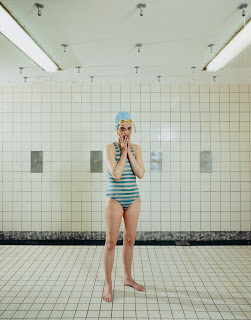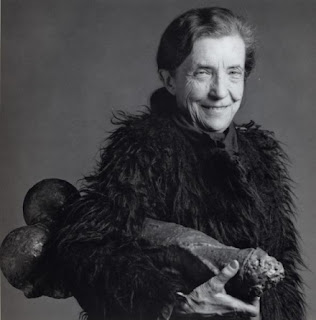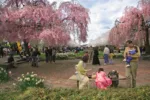
Lee Miller Self-Portrait in Headband, New York (1932), Lee Miller Archives © Lee Miller Archives, England 2008. All rights reserved. The last time Miller posed as a fashion model for Vogue she was the photographer as well. The credit ran photographer: Lee Miller, model: MISS LEE MILLER (COIFFURE BY DIMITRI)
There’s a confluence of exhibitions in or coming to Philadelphia that raise overlapping questions about women’s agency, their representation and self-presentation. They’ve also got me thinking about the extent to which one should consider biography in assessing artwork, something I’m not inclined to do.
The Art of Lee Miller opened at the Philadelphia Museum of Art (PMA) last week, where it runs through April 27. Miller’s photography has been known, up to now, only in its reproduced form. The 140 works in the exhibition, organized by Mark Haworth-Booth for the Victoria and Albert Museum, London consist mostly of vintage prints by Miller and by a group of well-known photographers for whom she modeled (Arnold Genthe, Edward Steichen, George Hoynengen Huene and Man Ray).

Lee Miller Women with Fire Masks, Devonshire Hill, London (1941) modern print by Carol Callow, Lee Miller Archives © Lee Miller Archives, England 2008. All rights reserved. The first of Miller’s work published in Vogue (and its British version, Brogue) was taken in London at the beginning of WWII, although they didn’t print this image of two women at the entrance to an air raid shelter wearing masks to protect them from incendiary bombs. The disorienting effect of the protective gear recalls Miller’s early involvement with the Surrealists in Paris.
Miller’s work as a photographer was a product of the opportunities available to her rather than any obviously self-generated plan. She modeled for magazines and artists during the 1920s, hung out with a group of Surrealists before turning to portraiture in the 30s, and did war reportage in the 40s. Perhaps this is why I have difficulty conceiving of her work as an oeuvre. She used her beauty to get a foot in the door to the fashion world of Vogue and into Man Ray’s Paris studio, where she worked from 1929-32. But it took gumption rather than looks for a 25-year-old woman to open her own commercial photography business in New York in 1932.
The same gumption was behind her war work. Her first photographs for Vogue were fashion shoots but she moved on to pictures of London during the Blitz then became an official US Army War Correspondent and covered subjects ranging from a military hospital in Normandy and bombings in St. Malo to the liberation of Buchenwald. At this point she was writing the text as well as providing the pictures and her articles seethed with anger at the Germans she met who would deny knowing about the atrocities of the death camps. One of the most remarkable things in the exhibition was to see an American fashion magazine publishing some of the most gruesome pictures to come out of the war.
It’s difficult, if not impossible, for women today to have any idea of the resistance Miller must have faced in the almost entirely-male worlds of art, commercial and journalistic photography. Her one obvious acknowledgment of this is a repellent double photo (two views) of a severed breast on a plate at a table setting; Take that! she seems to say, as a riposte to the Surrealist penchant for nude, bound and dismembered female bodies.

Lee Miller Burgermeister of Leipzig’s Daughter Suicided, Leipzig, Germany (1945), Lee Miller Archives © Lee Miller Archives, England 2008. All rights reserved. Vogue included this photograph in a spread captioned The Nazi Harvest, which included Miller’s photographs of piles of dead bodies at Buchenwald.
Next month the PMA will open an exhibition of her exact contemporary, Frida Kahlo, another woman who struggled to be taken seriously within a male artworld. Frida’s public persona was every bit as much a work of art as her paintings, though perhaps that was her way of getting her foot in the door.
While the PMA will be showing two exhibitions of exceptional women, its modern and contemporary painting and sculpture department continues to exhibit almost entirely white guys (with minor exceptions of an installation by the African, Georges Adeagbo, and videos by Marine Hugonnier). I also continue to be amazed by the museum’s segregated hanging of a group of paintings by African-American artists —Horace Pippin, William H. Johnson, Jacob Lawrence, Beauford Delaney, Alma Thomas, Bob Thompson–in the ground-floor corridor between the coat room and the gift shop, with only one Milton Avery to integrate the group. Don’t they belong in the upstairs galleries either?

Anna Gaskell Untitled #1 (Wonder) 1996 C-print, Collection Debra and Dennis Scholl, © Anna Gaskell
It’s not such a surprise that Moore College of Art, an all-woman’s school, should host an exhibition devoted to women artists who portray women, often themselves. The exhibition titled In Repose, organized by Lorie Mertes for The Galleries at Moore, is drawn from the private collection of Debra and Dennis Scholl (of Miami Beach). Almost all of the work is photographic (either prints or video) and coming from Lee Miller’s work I found the exhibition particularly disturbing. The artists, after all, are mostly two generations younger than Miller yet, with the exception of Carolee Schneeman and Mariko Mori, what they show are damsels in distress.
Their subjects are slashed, bound and constrained either literally or by society’s expectations. Pipilotti Rist’s I’m Not the Girl Who Misses Much shows the artist in a bosom-revealing dress, dancing and singing but speeded up so she looks and sounds like a delirious wind-up doll; Janine Antoni’s fashionably painted fingernails (Ingrown) have become so long that the nails of both hands fuse; Anna Gaskell’s girl/woman (dressed after Tenniel’s illustrations to Alice in Wonderland) in the series Wonder is trapped in her clothes or about to drown; Naomi Fisher’s women are tortured, violated or dead; Rineke Dijkstra depicts herself at a public swimming pool looking stunned, like a deer caught in headlights.

Women may still be having trouble in the artworld and the greater world beyond, but it was depressing to see that as the subject of so much work, despite the presence of artists I respect.

Robert Mapplethorpe Louise Bourgeois in 1982 with ‘Filette'(1968) , ©Robert Mapplethorpe
Speaking of remarkable women, my doorbell just rang and it was the postman delivering a copy of Louise Bourgeois, the catalogue to the large exhibition that I saw at the Tate Modern last year (edited by Frances Morris and Marie-Laure Bernadac, Rizzoli in association with the Tate Modern, ISBN 978-0-8478-3131-9). Bourgeois is certainly one of the few women artists of Lee Miller’s and Frida Kahlo’s generation who still survives and is productive (Eve Zeisel, b.1906, is still working as well, I believe). Bourgeois has always plumbed her psyche in her work and reveled in its feminine fecundity. Unafraid of exploring the varieties of desire, she famously posed for Robert Mapplethorpe with one of her sculptures, shaped like a huge phallus, tucked under her arm (above). The catalog has essays by no fewer than eight authors, among them the psychoanalyst and critic Julia Kristeva. Can’t wait to read it.








